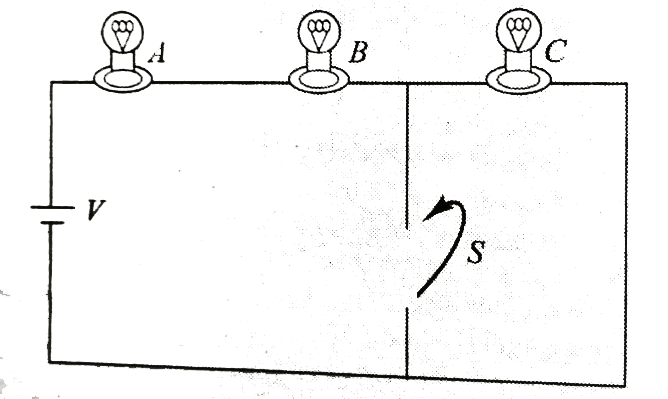The cathode of a diode valve is replaced by another cathode of double the surface area. Keeping the voltage and temperature conditions the same, will the plate current decrease, increase or remain the same?
To solve the problem, we need to analyze the relationship between the plate current in a diode and the surface area of the cathode using the Richardson-Dushman equation. Here’s a step-by-step breakdown:
Step 1: Understand the Richardson-Dushman Equation
The Richardson-Dushman equation describes the plate current (I) in thermionic emission as:
I=AsT2e−ΦkT
where:
- I = plate current
- As = surface area of the cathode
- T = absolute temperature
- Φ = work function of the cathode material
- k = Boltzmann's constant
Step 2: Identify the Variables
In the given problem:
- The surface area of the cathode is doubled.
- The voltage and temperature conditions are kept the same.
Step 3: Analyze the Effect of Doubling the Surface Area
From the Richardson-Dushman equation, we can see that the plate current (I) is directly proportional to the surface area (A_s). This means:
I∝As
If the surface area is doubled (i.e., As becomes 2As), the plate current will also double:
I′=2AsT2e−ΦkT=2I
Step 4: Conclusion
Since the surface area is doubled, the plate current will also double. Therefore, the plate current will increase.
Final Answer
The plate current will increase when the cathode surface area is doubled, keeping the voltage and temperature conditions the same.
---
The Richardson-Dushman equation describes the plate current (I) in thermionic emission as:
I=AsT2e−ΦkT
where:
- I = plate current
- As = surface area of the cathode
- T = absolute temperature
- Φ = work function of the cathode material
- k = Boltzmann's constant
In the given problem:
- The surface area of the cathode is doubled.
- The voltage and temperature conditions are kept the same.
From the Richardson-Dushman equation, we can see that the plate current (I) is directly proportional to the surface area (A_s). This means:
I∝As
If the surface area is doubled (i.e., As becomes 2As), the plate current will also double:
I′=2AsT2e−ΦkT=2I
Since the surface area is doubled, the plate current will also double. Therefore, the plate current will increase.
The plate current will increase when the cathode surface area is doubled, keeping the voltage and temperature conditions the same.
Topper's Solved these Questions
- ELECTRIC CURRENT THROUGH GASESBOOK - HC VERMA ENGLISHCHAPTER - ELECTRIC CURRENT THROUGH GASESEXERCISE - Exercise
23 Videos
- ELECTRIC CURRENT IN CONDUCTORSBOOK - HC VERMA ENGLISHCHAPTER - ELECTRIC CURRENT IN CONDUCTORSEXERCISE - questions for short answer
17 Videos
- ELECTRIC FIELD AND POTENTIALBOOK - HC VERMA ENGLISHCHAPTER - ELECTRIC FIELD AND POTENTIALEXERCISE - Objective 2
7 Videos
Similar Questions
A cyclist doubles his speed. How will his kinetic energy change : increases, decreases or remains the same ?
View SolutionA parallel -plate capacitor is connected to a battery that maintains a constant potential difference V between the plates. If the plates are pulled away from each other, increasing their separation, does the magnitude of the charge on the plates (a) increase, (b) decrease, or (c ) remain the same ?
View Solution
Knowledge Check
There is a hole in the middle of a copper plate . When heating the plate , diameter of hole would a) always increase b) always decrease c) remains the same d) none of these
Aalways increaseBalways decreaseCremains the sameDnone of these
A series circuit consists of three identical lamps connected to a battery as shown in Fig. 7.13.
when the switch S is closed, what happens
(a) to the intensities of lamps AandB,
(b) to the intensity of lamp C,
( c ) to the current in the circuit , and
(d) to the voltage drop across the three lamps ?
Does the power dissipated in the circuit increase, decrease, or remain the same ?

View SolutionA container having some gas was kept in a moving train. The temperature of the gas in the container will
A. increase slightly
B. decrease
C. remain the same
D. become infinite
View SolutionThe capacitance of a parallel plate capacitor when a very thin metallic sheet is placed in the space between the plates, parallel to the plates , will
(1) Increase (2) Decreases
(3) Remain same (4) Nothing can be said
View SolutionThe distance between the plates of a plane capacitor is 10 mm, the voltage is 10 kV. A sheet of mica of the same dimensions as those of the plates is then inserted between the plates. Find the polarization charge on the surface of the mica sheet assuming the plates to remain connected to the power supply.
View SolutionTwo plates of equal areas are placed in contact wih each other. Their thickness are 2.0 cm and 5.0 cm respectively. The temperature of the external surface of the first plate is −20∘C and that of the external surface of the second plate is 20∘C. What will be the temperature of the current surface if the plates (i) are of the same material, (ii) have thermal conductivities in the ratio 2:5.
View SolutionThe temperature of a body is doubled but the rate fo theat radiaton remains same due to change in its surface area. The ratio of initial area to final area is
View SolutionSTATEMENT-1 : In a meter bridge, if its wire is replaced by another wire having same length, same material but twice the cross sectional area, then the accuracy of measurement decreases.
and
STATEMENT-2 : Accuracy of meter bridge depends on the length of wire.
View Solution
